Implementation and Analysis of Tightly Coupled Global Navigation Satellite System Precise Point Positioning/Inertial Navigation System (GNSS PPP/INS) with Insufficient Satellites for Land Vehicle Navigation
Abstract
1. Introduction
2. Fundamentals of GNSS/INS Integration
2.1. GNSS PPP
2.2. INS Mechanization
2.3. GNSS/INS Integrated Navigation
3. INS Error Accumulation and Mitigation
4. Field Tests and Results
5. Conclusions
Author Contributions
Funding
Conflicts of Interest
References
- Dorn, M.; Filwarny, J.O.; Wieser, M. Inertially-aided RTK based on tightly-coupled integration using low-cost GNSS receivers. In Proceedings of the 2017 European Navigation Conference (ENC), Lausanne, Switzerland, 9–12 May 2017; pp. 186–197. [Google Scholar]
- Eling, C.; Klingbeil, L.; Kuhlmann, H. Real-Time Single-Frequency GPS/MEMS-IMU Attitude Determination of Lightweight UAVs. Sensors 2015, 15, 26212–26235. [Google Scholar] [CrossRef] [PubMed]
- Falco, G.; Gutiérrez, C.C.; Serna, E.P.; Zacchello, F.; Bories, S. Low-cost Real-time Tightly-Coupled GNSS/INS Navigation System Based on Carrier-phase Double-differences for UAV Applications. In Proceedings of the 27th International Technical Meeting of the Satellite Division of the Institute of Navigation (ION GNSS+ 2014), Tampa, FL, USA, 8–12 September 2014. [Google Scholar]
- Solimeno, A. Low-Cost INS/GPS Data Fusion with Extended Kalman Filter for Airborne Applications. Master’s Thesis, Universidade Technica de Lisboa, Lisbon, Portugal, 2007. [Google Scholar]
- Falco, G.; Einicke, G.A.; Malos, J.T.; Dovis, F. Performance Analysis of Constrained Loosely Coupled GPS/INS Integration Solutions. Sensors 2012, 12, 15983–16007. [Google Scholar] [CrossRef] [PubMed]
- Godha, S. Performance Evaluation of Low Cost MEMS-Based IMU Integrated with GPS for Land Vehicle Navigation Application; UCGE Report Number 20239; University of Calgary: Calgary, AB, Canada, 2006. [Google Scholar]
- Nguyen, V.H. Loosely coupled GPS/INS integration with Kalman filtering for land vehicle applications. In Proceedings of the 2012 International Conference on Control, Automation and Information Sciences (ICCAIS), Ho Chi Minh, Vietnam, 26–29 November 2012; pp. 90–95. [Google Scholar]
- Godha, S.; Cannon, M.E. GPS/MEMS INS integrated system for navigation in urban areas. Gps Solut. 2007, 11, 193–203. [Google Scholar] [CrossRef]
- Han, H.; Wang, J.; Wang, J.; Tan, X. Performance analysis on carrier phase-based tightly-coupled GPS/BDS/INS integration in GNSS degraded and denied environments. Sensors 2015, 15, 8685–8711. [Google Scholar] [CrossRef] [PubMed]
- Carvalho, C.M.; Johannes, M.S.; Lopes, H.F.; Polson, N.G. Particle learning and smoothing. Stat. Sci. 2010, 25, 88–106. [Google Scholar] [CrossRef]
- Kotecha, J.H.; Djuric, P.M. Gaussian sum particle filtering. IEEE Trans. Signal Process. 2003, 51, 2602–2612. [Google Scholar] [CrossRef]
- Martino, L.; Elvira, V.; Camps-Valls, G. Group Importance Sampling for particle filtering and MCMC. Digit. Signal Process. 2018, 82, 133–151. [Google Scholar] [CrossRef]
- Wan, E.A.; Van Der Merwe, R. The unscented Kalman filter. In Kalman Filtering and Neural Networks; John Wiley & Sons, Inc.: Hoboken, NJ, USA, 2001; pp. 221–280. [Google Scholar]
- Giremus, A.; Tourneret, J.-Y.; Djuric, P.M. An improved regularized particle filter for GPS/INS integration. In Proceedings of the 2005 IEEE 6th Workshop on Signal Processing Advances in Wireless Communications, New York, NY, USA, 5–8 June 2005; pp. 1013–1017. [Google Scholar]
- Jgouta, M.; Nsiri, B. Integration of INS and GPS system using Particle Filter based on Particle Swarm Optimization. Int. J. Circuits Syst. Signal Process. 2015, 9, 461–466. [Google Scholar]
- Kubo, Y.; Wang, J. INS/GPS integration using gaussian sum particle filter. In Proceedings of the 21st International Technical Meeting of the Satellite Division of The Institute of Navigation (ION GNSS 2008), Savannah, GA, USA, 16–19 September 2008. [Google Scholar]
- Chiang, K.W.; Duong, T.T.; Liao, J.K. The performance analysis of a real-time integrated INS/GPS vehicle navigation system with abnormal GPS measurement elimination. Sensors 2013, 13, 10599–10622. [Google Scholar] [CrossRef] [PubMed]
- Shin, E.-H. Accuarcy Improvement of Low Cost INS/GPS for Land Applications; UCGE Report; University of Calgary: Calgary, AB, Canada, 2001. [Google Scholar]
- Cheng, J.; Kim, J.; Jiang, Z.; Zhang, W. Tightly Coupled SLAM/GNSS for Land Vehicle Navigation. Lect. Notes Electr. Eng. 2014, 305, 721–733. [Google Scholar]
- Skog, I. GNSS-Aided INS for Land Vehicle Positioning and Navigation. Ph.D. Thesis, KTH, Signal Processing, Stockholm, Sweden, 2007. [Google Scholar]
- Toro, F.G.; Becker, U.; Fuentes, D.E.D.; Lu, D.; Tao, W. Accuracy Analysis for GNSS-based Urban Land Vehicle Localisation System. IFAC PapersOnLine 2016, 49, 191–196. [Google Scholar] [CrossRef]
- Won, D.H.; Ahn, J.; Lee, E.; Heo, M.; Sung, S.; Lee, Y.J. GNSS Carrier Phase Anomaly Detection and Validation for Precise Land Vehicle Positioning. IEEE Trans. Instrum. Meas. 2015, 64, 2389–2398. [Google Scholar] [CrossRef]
- Li, B.; Zhang, Z.; Zang, N.; Wang, S. High-precision GNSS ocean positioning with BeiDou short-message communication. J. Geod. 2018, 1–15. [Google Scholar] [CrossRef]
- Li, X.; Ge, M.; Dai, X.; Ren, X.; Fritsche, M.; Wickert, J.; Schuh, H. Accuracy and reliability of multi-GNSS real-time precise positioning: GPS, GLONASS, BeiDou, and Galileo. J. Geod. 2015, 89, 607–635. [Google Scholar] [CrossRef]
- Bisnath, S.B.; Gao, Y. Precise Point Positioning. Gps World 2009, 4, 43–50. [Google Scholar]
- Liu, F. Tightly Coupled Integration of GNSS/INS/Stereo Vision/Map Matching System for Land Vehicle Navigation; UCGE Report; University of Calgary: Calgary, AB, Canada, 2018. [Google Scholar]
- Saastamoinen, J. Atmospheric correction for the troposphere and stratosphere in radio ranging satellites. Use Artif. Satell. Geod. 1972, 15, 247–251. [Google Scholar]
- Kouba, J.; Héroux, P. Precise Point Positioning Using IGS Orbit and Clock Products. GPS Solut. 2001, 5, 12–28. [Google Scholar] [CrossRef]
- Rothacher, M.; Beutler, G. The role of GPS in the study of global change. Phys. Chem. Earth 1998, 23, 1029–1040. [Google Scholar] [CrossRef]
- Odijk, D. Ionosphere-free phase combinations for modernized GPS. J. Surv. Eng. 2003, 129, 165–173. [Google Scholar] [CrossRef]
- Schaer, S. How to Use CODE’s Global Ionosphere Maps; Astronomical Institute, University of Berne: Berne, Switzerland, 1997; pp. 1–9. [Google Scholar]
- Schaer, S.; Gurtner, W.; Feltens, J. IONEX: The ionosphere map exchange format version 1. In Proceedings of the IGS AC Workshop, Darmstadt, Germany, 9–11 February 1998; Volume 9. [Google Scholar]
- Noureldin, A.; Karamat, T.B.; Georgy, J. Fundamentals of Inertial Navigation, Satellite-Based Positioning and Their Integration; Springer Science & Business Media: Heidelberg, Germany, 2013. [Google Scholar]
- Rogers, R.M. Applied Mathematics in Integrated Navigation Systems, 3rd ed.; American Institute of Aeronautics & Astronautics Inc.: Reston, VA, USA, 2015; p. 78. [Google Scholar]
- Hou, H. Modeling Inertial Sensors Errors Using Allan Variance; UCGE Report; University of Calgary: Calgary, AB, Canada, 2004. [Google Scholar]
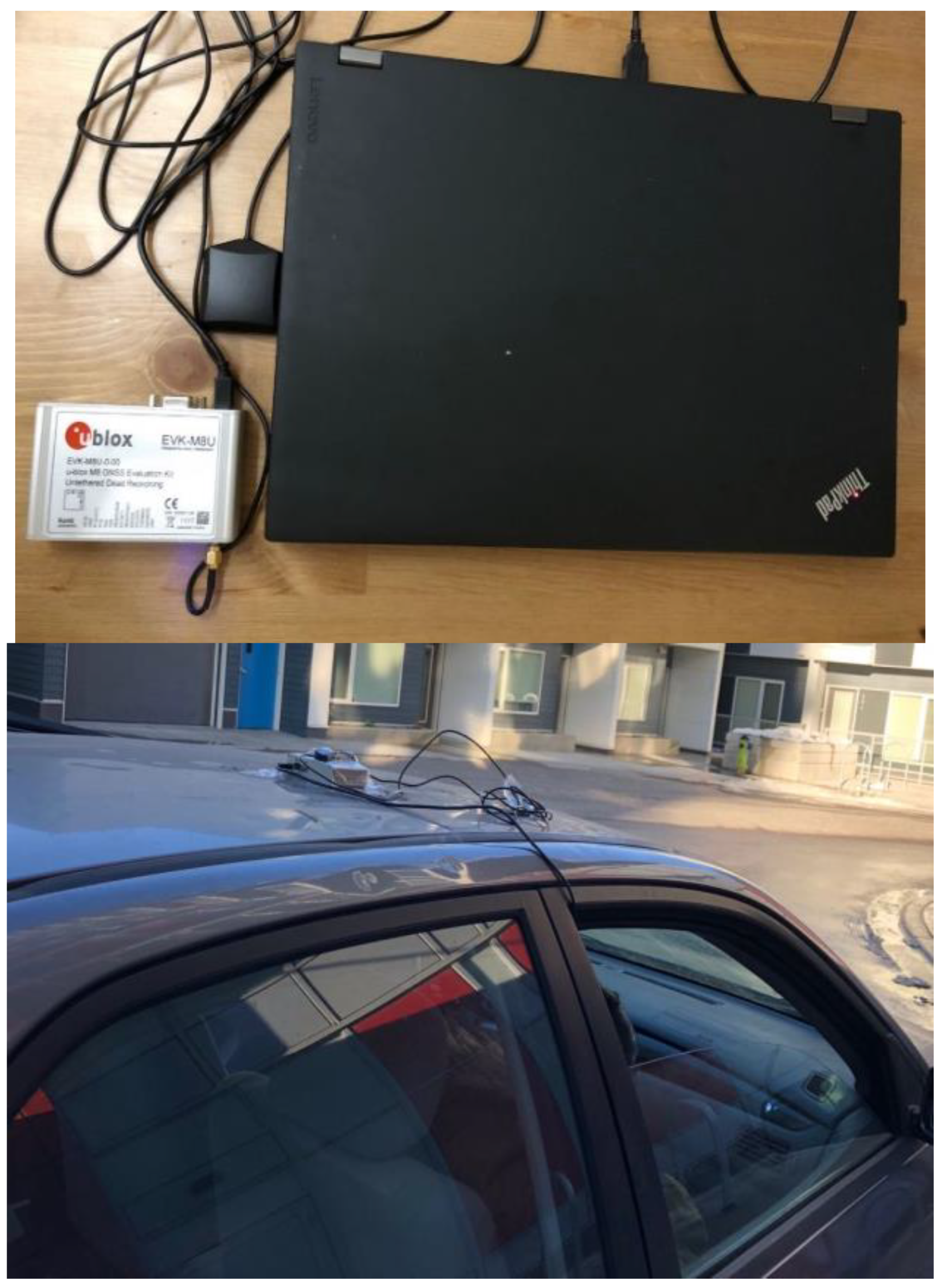
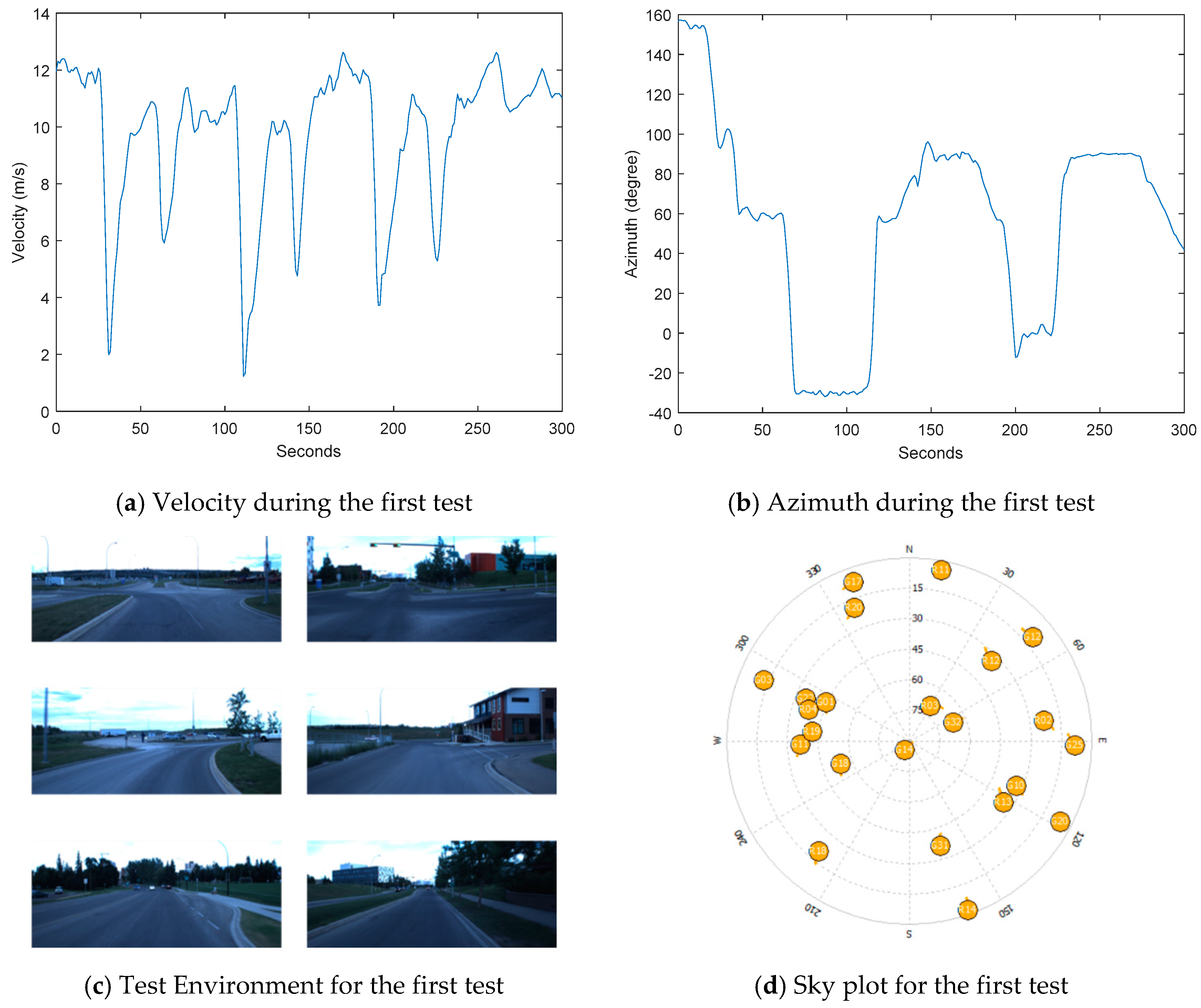
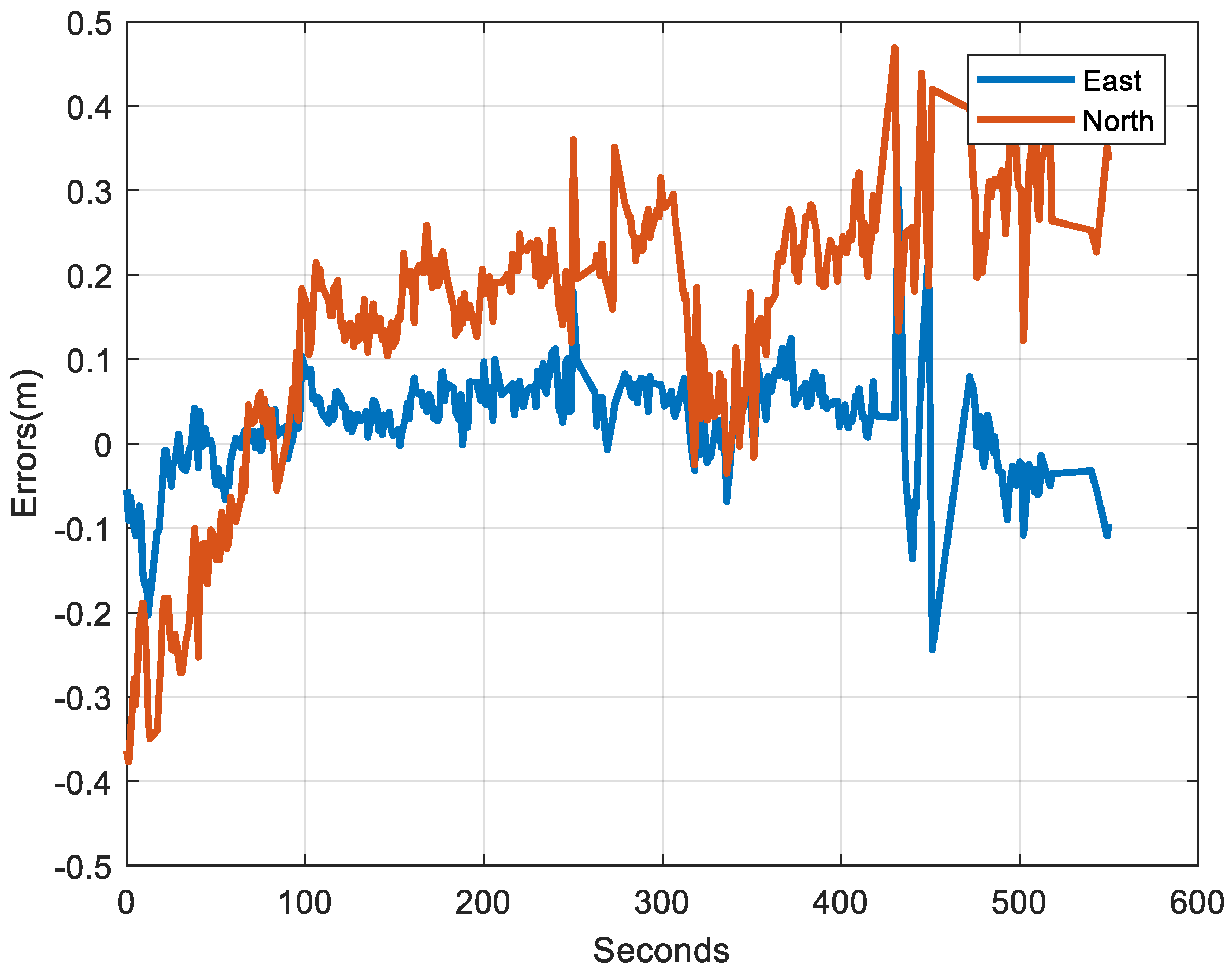
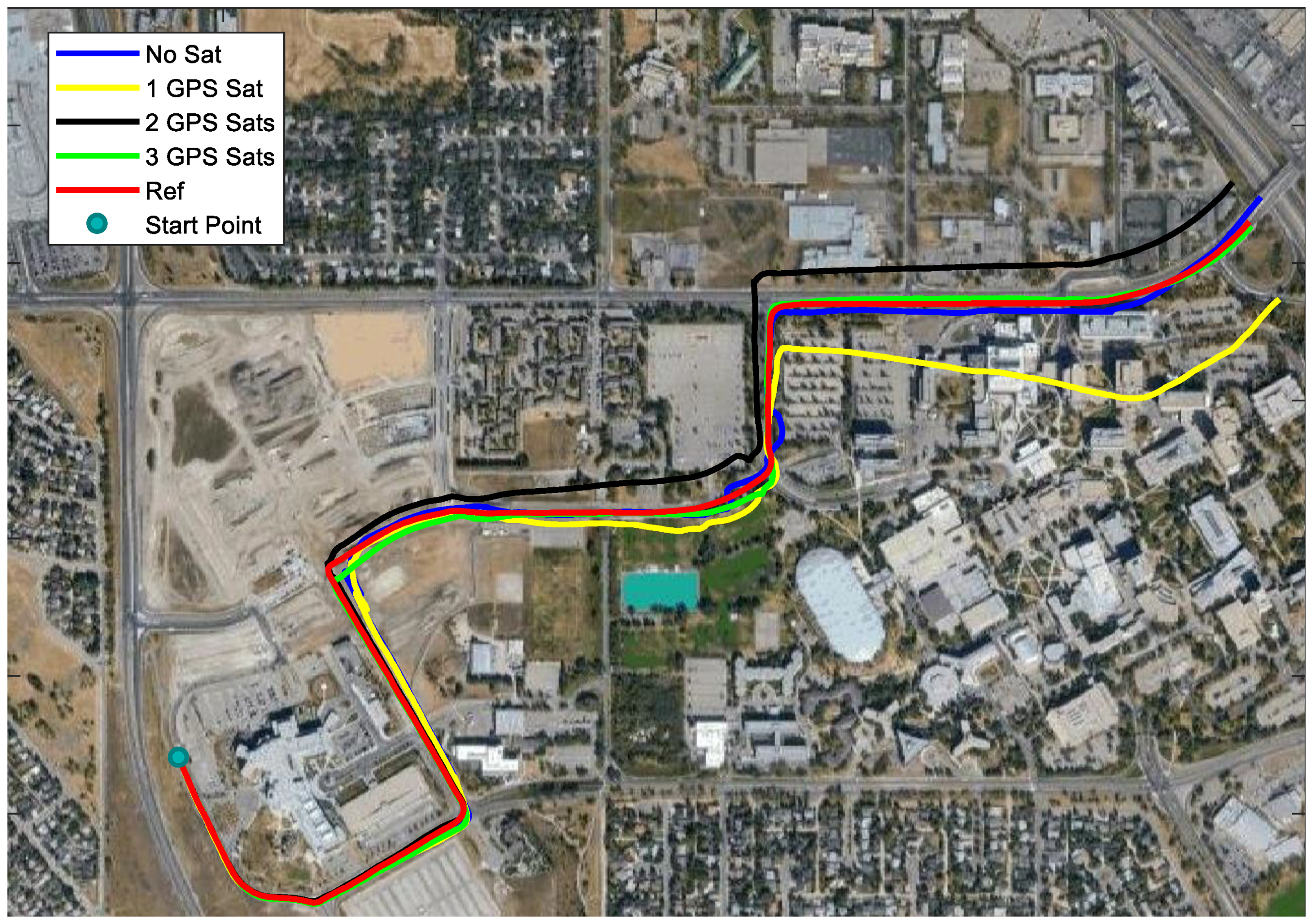

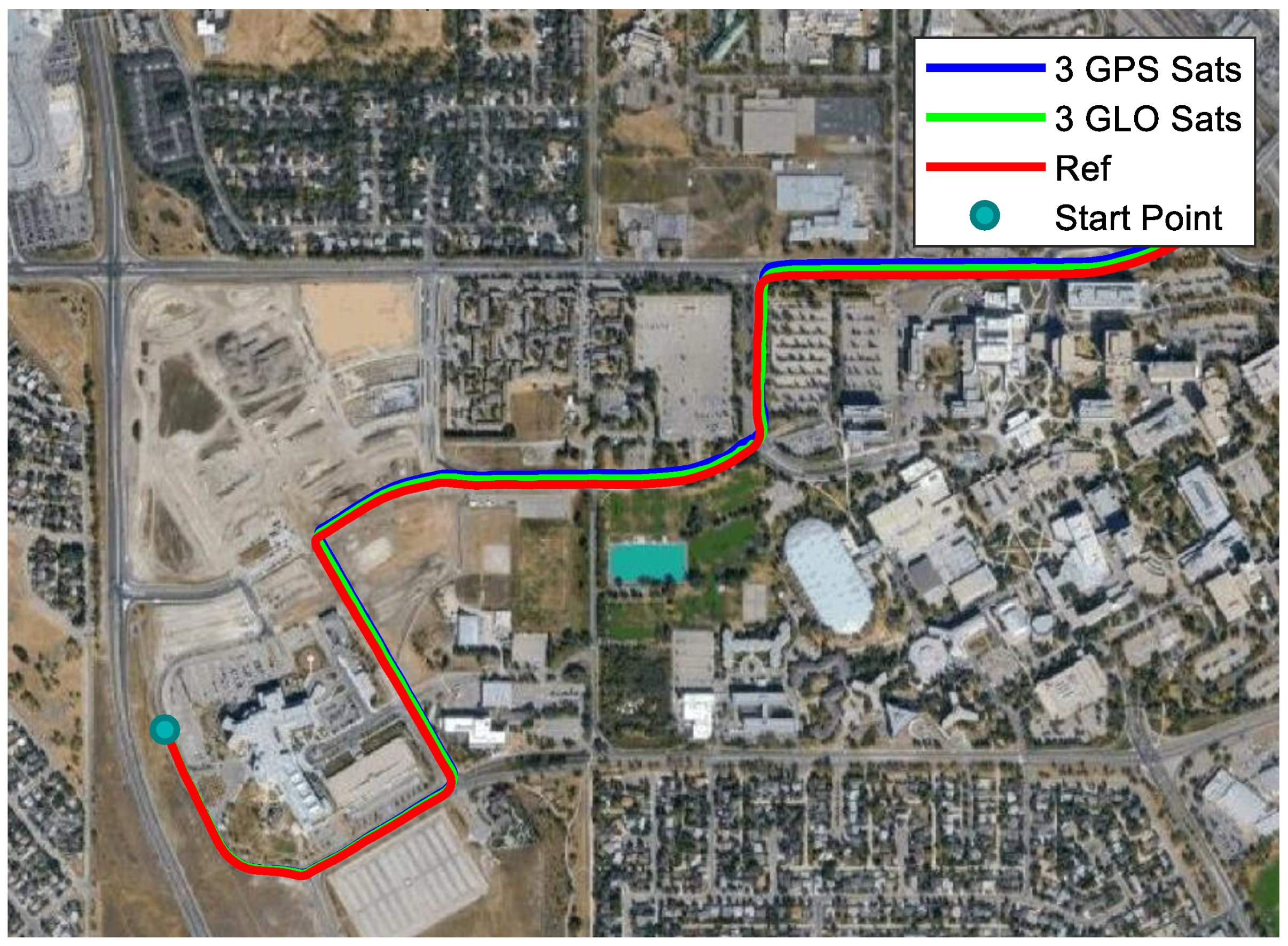
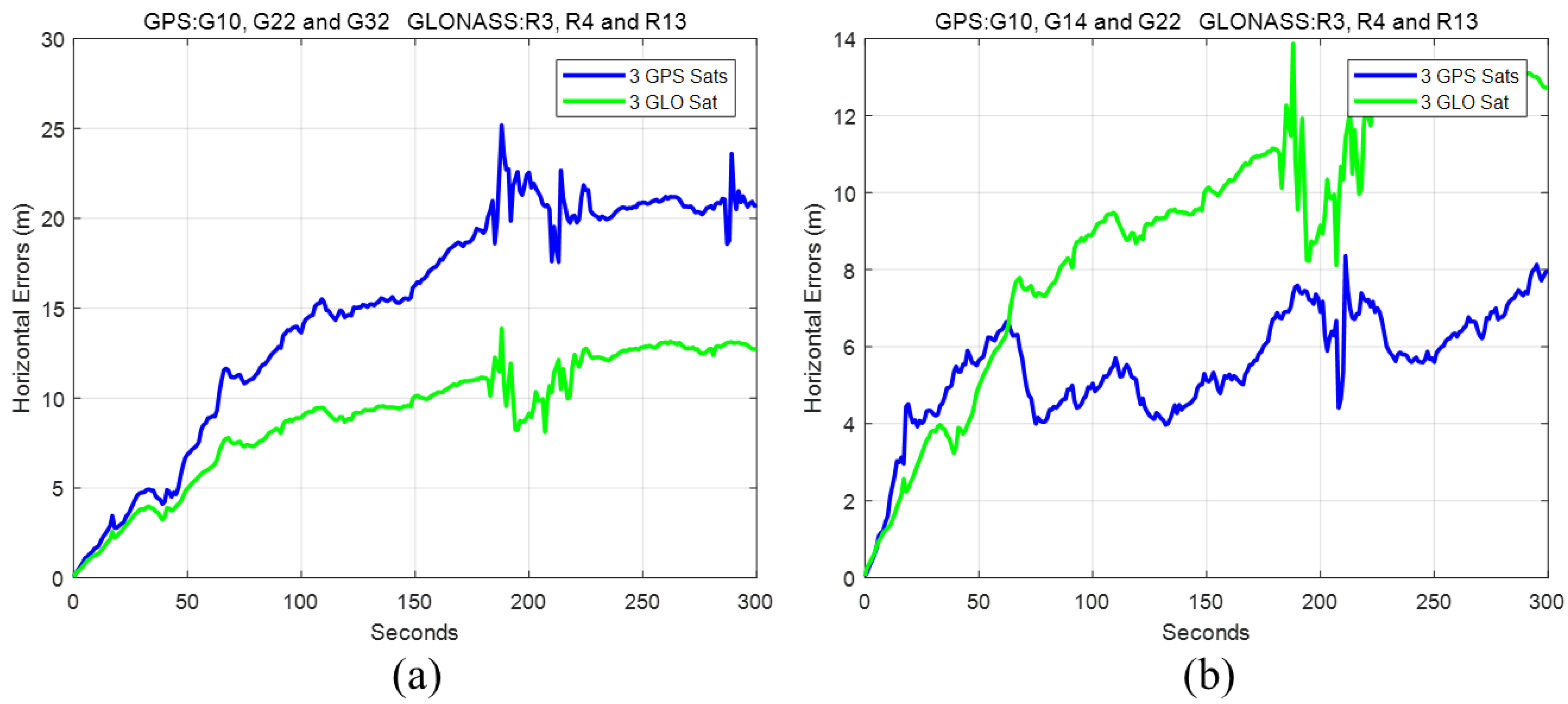
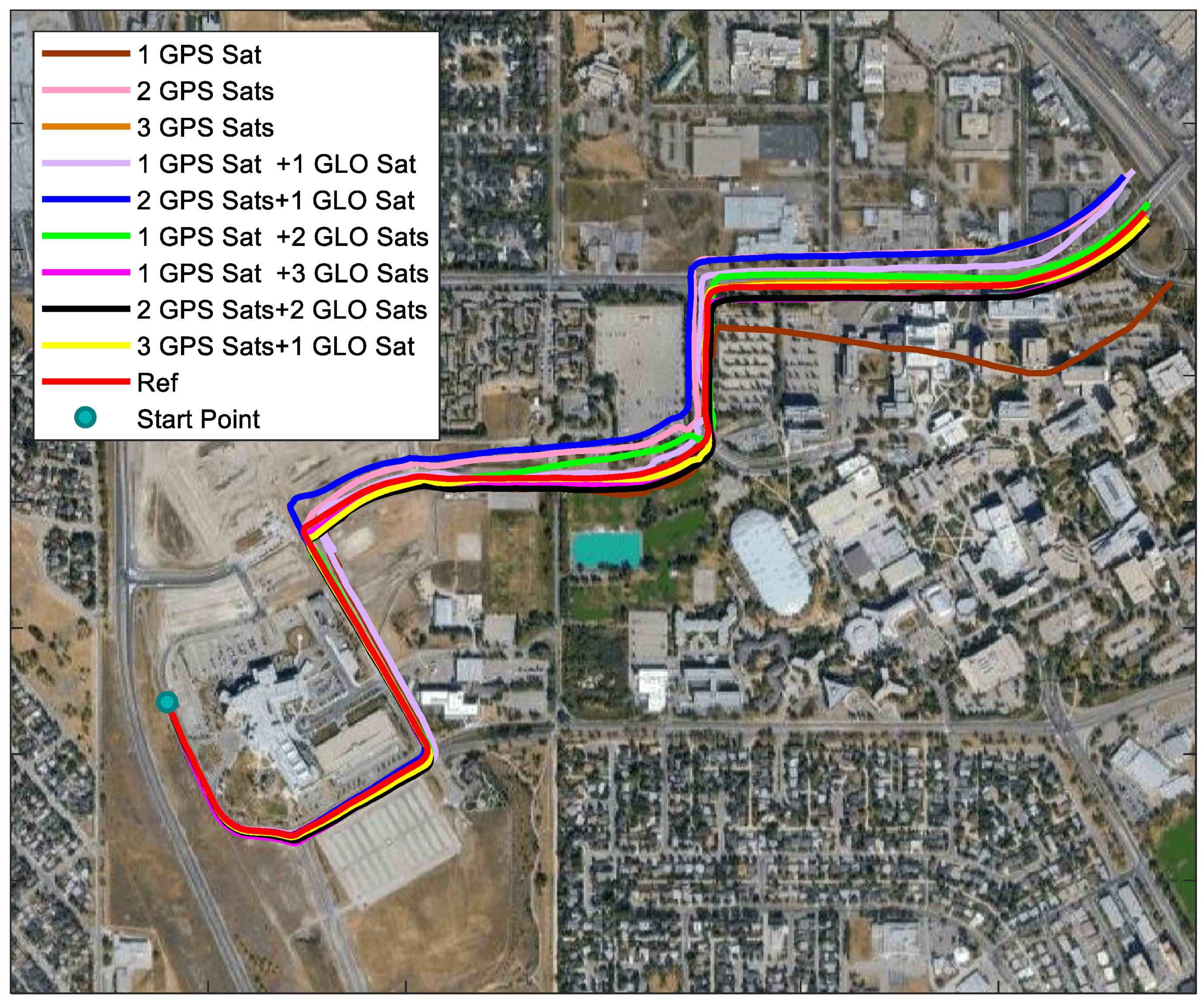
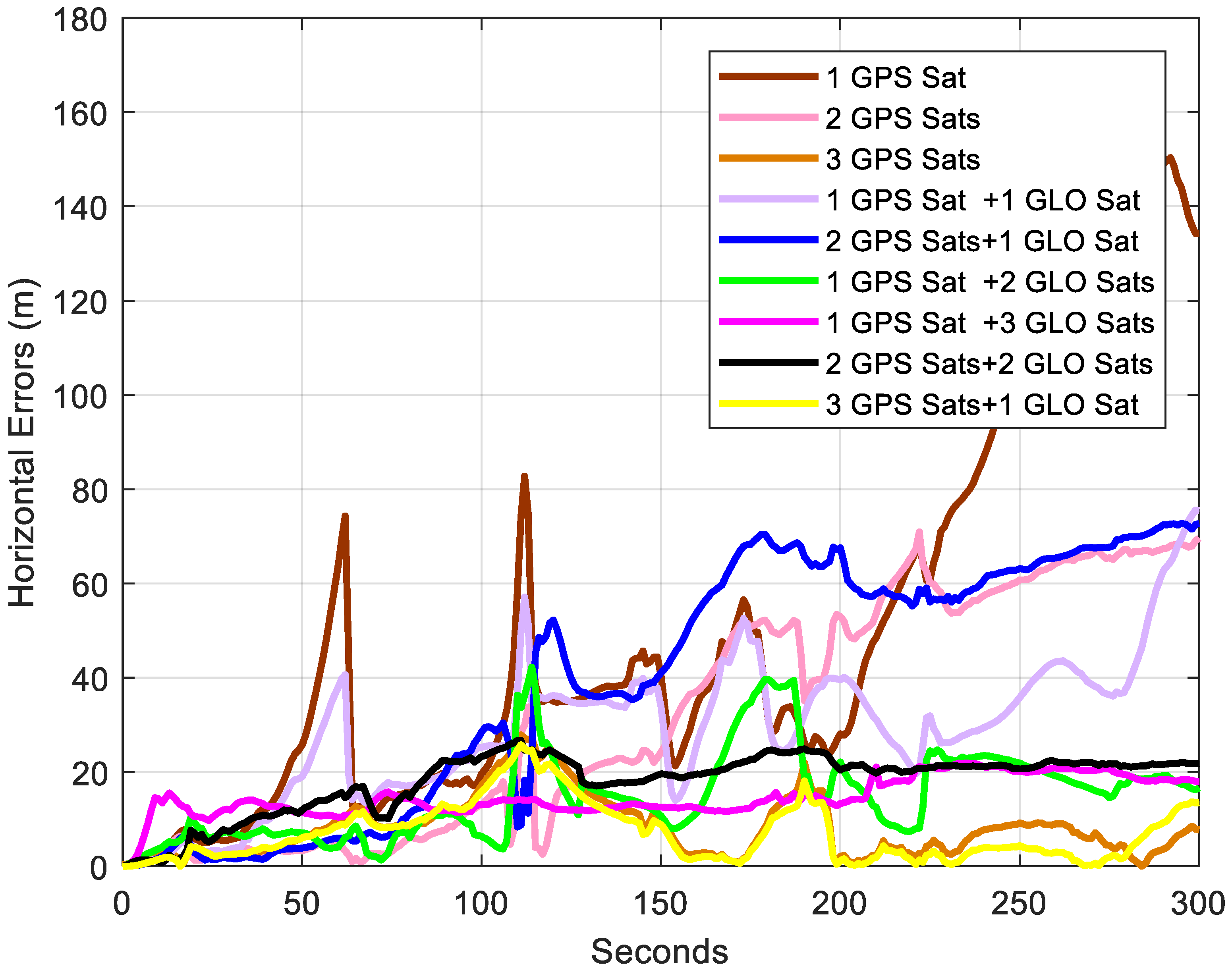
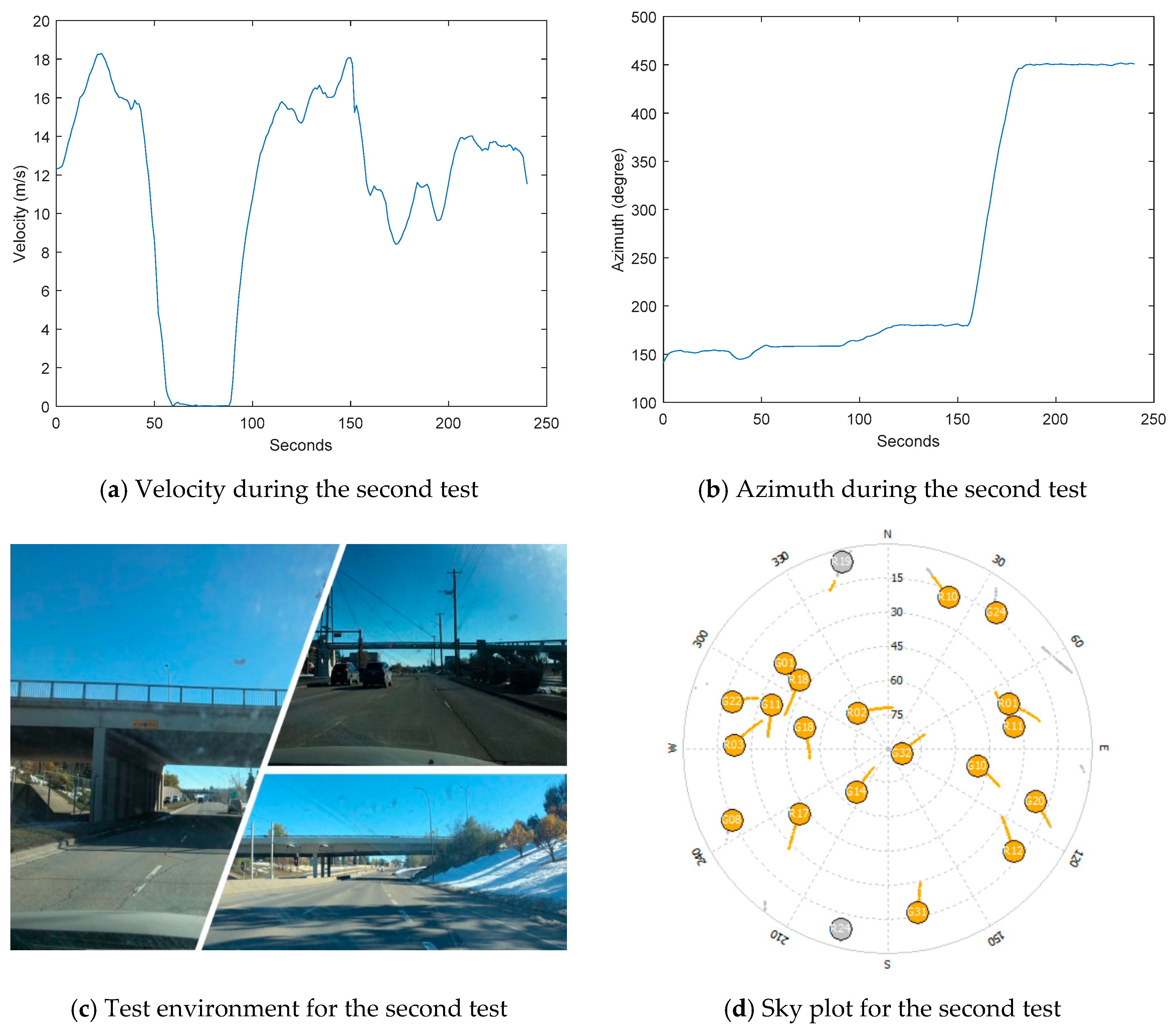

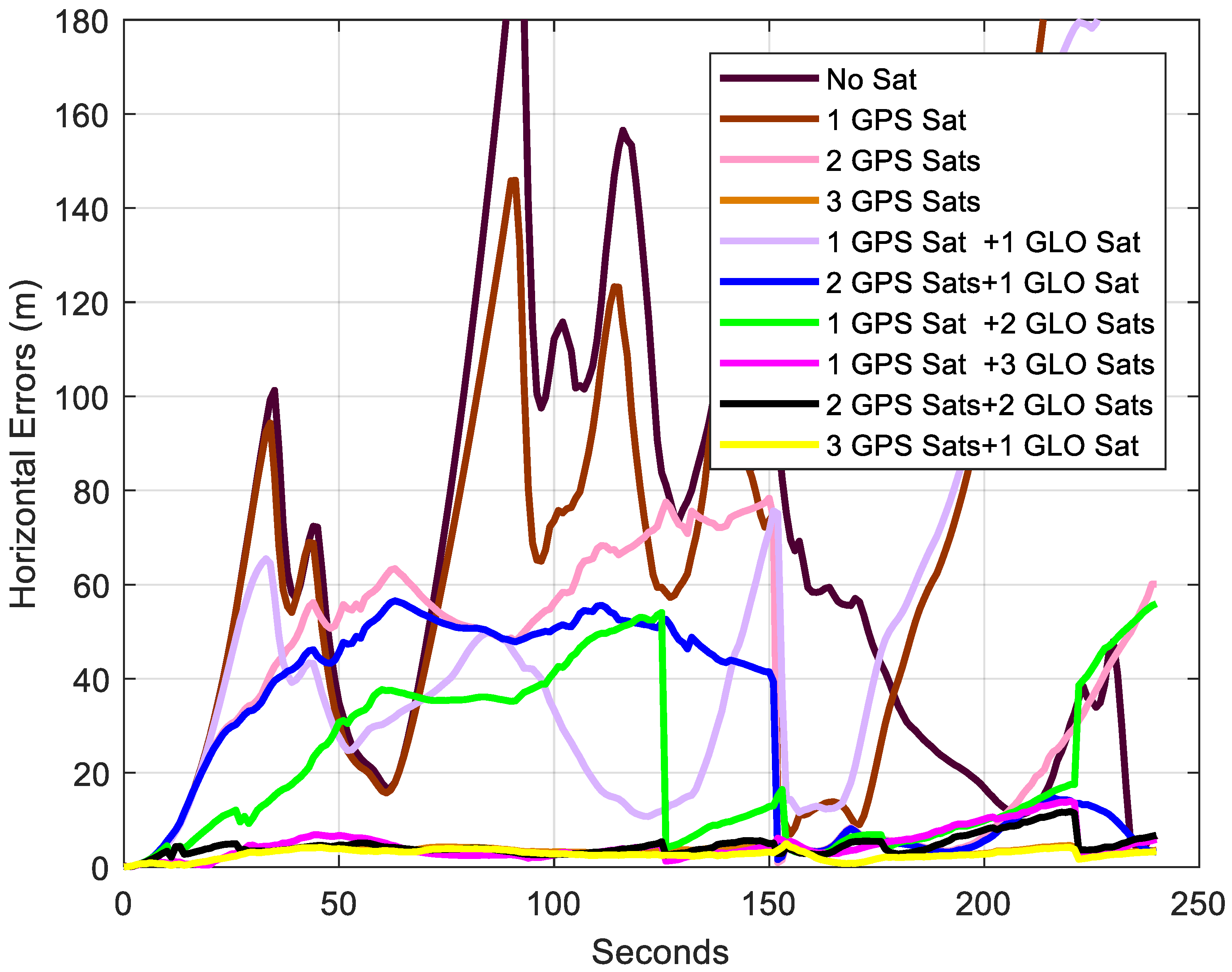

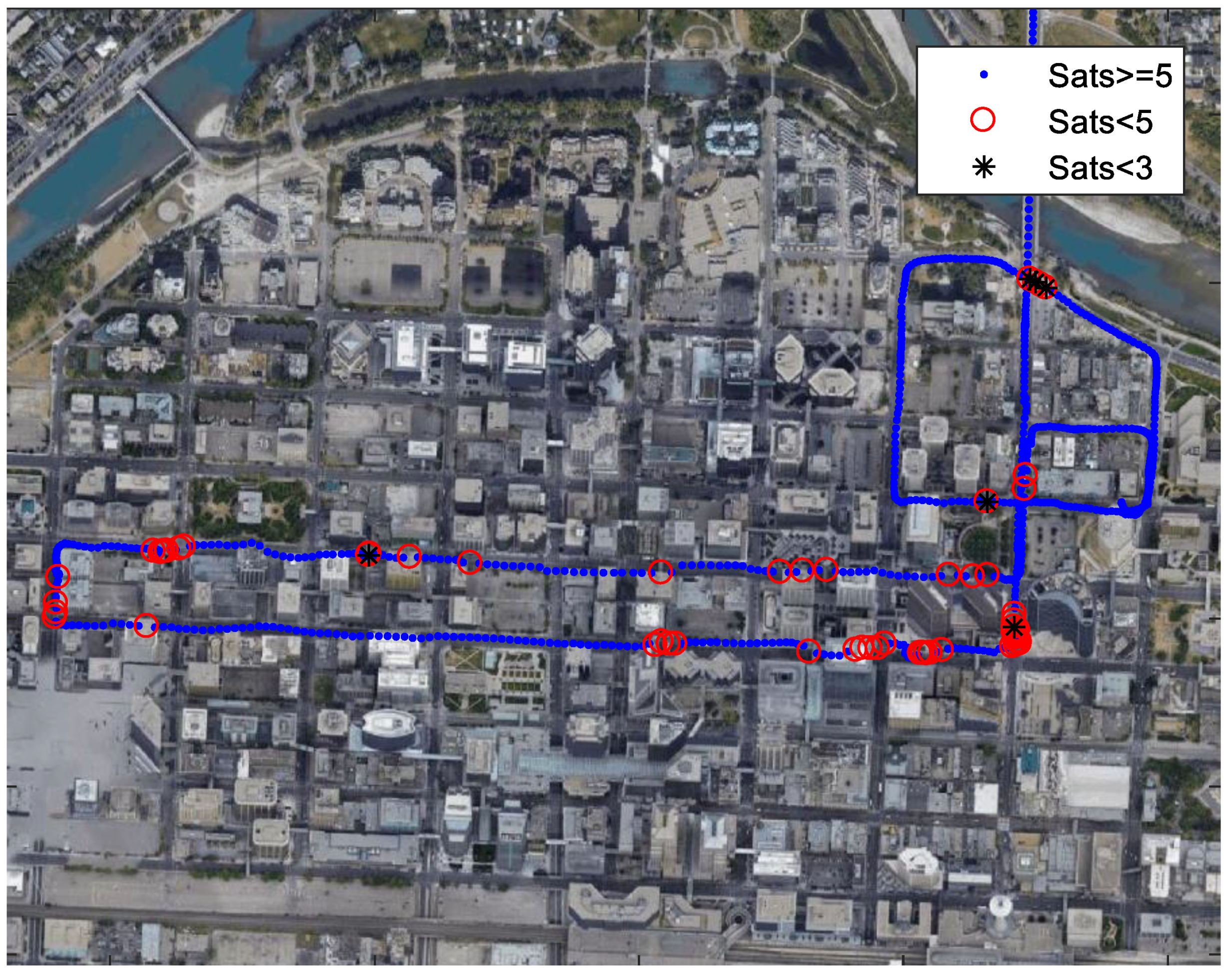
| Satellites Used | RMS (m) | Maximum Error (m) | Relative Horizontal Position Error |
|---|---|---|---|
| No sat | 29.153 | 77.435 | 1.00% |
| 1 GPS sat | 70.147 | 165.962 | 2.41% |
| 2 GPS sats | 40.938 | 70.918 | 1.40% |
| 3 GPS sats | 10.345 | 27.859 | 0.35% |
| 1 GPS sat & 1 GLO sat | 32.721 | 75.575 | 1.12% |
| 2 GPS sats & 1 GLO sat | 47.501 | 72.745 | 1.63% |
| 1 GPS sat & 2 GLO sats | 17.499 | 42.236 | 0.60% |
| 1 GPS sat & 3 GLO sats | 15.264 | 21.925 | 0.52% |
| 2 GPS sats & 2 GLO sats | 19.184 | 26.708 | 0.66% |
| 3 GPS sats & 1 GLO sats | 9.297 | 25.781 | 0.32% |
| Satellites Used | 3 s | 10 s | 30 s | 60 s |
|---|---|---|---|---|
| No sat | 0.530 | 1.909 | 7.346 | 21.544 |
| 1 GPS sat | 0.519 | 1.913 | 7.257 | 19.226 |
| 2 GPS sats | 0.290 | 1.036 | 4.730 | 12.286 |
| 3 GPS sats | 0.455 | 1.104 | 2.896 | 6.469 |
| 1 GPS sat & 1 GLO sat | 0.380 | 1.684 | 6.830 | 17.676 |
| 2 GPS sats & 1 GLO sat | 0.295 | 1.088 | 4.911 | 12.542 |
| 1 GPS sat & 2 GLO sats | 0.592 | 1.999 | 5.828 | 10.622 |
| 1 GPS sat & 3 GLO sats | 0.953 | 6.651 | 10.492 | 13.105 |
| 2 GPS sats & 2 GLO sats | 0.577 | 2.146 | 5.944 | 10.744 |
| 3 GPS sats & 1 GLO sats | 0.258 | 0.873 | 2.894 | 6.190 |
| Satellites Used | RMS (m) | Maximum Error (m) | Relative Horizontal Position Error |
|---|---|---|---|
| No sat | 75.384 | 200.871 | 2.75% |
| 1 GPS sat | 101.945 | 263.778 | 3.73% |
| 2 GPS sats | 46.155 | 78.344 | 1.69% |
| 3 GPS sats | 3.248 | 4.945 | 0.12% |
| 1 GPS sat & 1 GLO sat | 79.460 | 208.918 | 2.91% |
| 2 GPS sats & 1 GLO sat | 35.668 | 56.542 | 1.31% |
| 1 GPS sat & 2 GLO sats | 28.046 | 55.919 | 1.03% |
| 1 GPS sat & 3 GLO sats | 5.509 | 13.952 | 0.20% |
| 2 GPS sats & 2 GLO sats | 4.935 | 11.791 | 0.18% |
| 3 GPS sats & 1 GLO sats | 2.878 | 4.956 | 0.11% |
| Satellites Used | 3 s | 10 s | 30 s | 60 s |
|---|---|---|---|---|
| No sat | 0.475 | 2.663 | 20.109 | 58.576 |
| 1 GPS sat | 0.451 | 1.847 | 20.245 | 45.248 |
| 2 GPS sats | 0.446 | 1.930 | 10.080 | 20.443 |
| 3 GPS sats | 0.402 | 1.146 | 3.967 | 7.058 |
| 1 GPS sat & 1 GLO sat | 0.449 | 1.835 | 16.971 | 24.238 |
| 2 GPS sats & 1 GLO sat | 0.444 | 1.920 | 9.800 | 17.631 |
| 1 GPS sat & 2 GLO sats | 0.376 | 1.713 | 5.816 | 17.142 |
| 1 GPS sat & 3 GLO sats | 0.330 | 1.078 | 3.526 | 5.763 |
| 2 GPS sats & 2 GLO sats | 0.372 | 1.351 | 4.288 | 7.496 |
| 3 GPS sats & 1 GLO sats | 0.399 | 1.134 | 3.875 | 6.684 |
© 2018 by the authors. Licensee MDPI, Basel, Switzerland. This article is an open access article distributed under the terms and conditions of the Creative Commons Attribution (CC BY) license (http://creativecommons.org/licenses/by/4.0/).
Share and Cite
Liu, Y.; Liu, F.; Gao, Y.; Zhao, L. Implementation and Analysis of Tightly Coupled Global Navigation Satellite System Precise Point Positioning/Inertial Navigation System (GNSS PPP/INS) with Insufficient Satellites for Land Vehicle Navigation. Sensors 2018, 18, 4305. https://doi.org/10.3390/s18124305
Liu Y, Liu F, Gao Y, Zhao L. Implementation and Analysis of Tightly Coupled Global Navigation Satellite System Precise Point Positioning/Inertial Navigation System (GNSS PPP/INS) with Insufficient Satellites for Land Vehicle Navigation. Sensors. 2018; 18(12):4305. https://doi.org/10.3390/s18124305
Chicago/Turabian StyleLiu, Yue, Fei Liu, Yang Gao, and Lin Zhao. 2018. "Implementation and Analysis of Tightly Coupled Global Navigation Satellite System Precise Point Positioning/Inertial Navigation System (GNSS PPP/INS) with Insufficient Satellites for Land Vehicle Navigation" Sensors 18, no. 12: 4305. https://doi.org/10.3390/s18124305
APA StyleLiu, Y., Liu, F., Gao, Y., & Zhao, L. (2018). Implementation and Analysis of Tightly Coupled Global Navigation Satellite System Precise Point Positioning/Inertial Navigation System (GNSS PPP/INS) with Insufficient Satellites for Land Vehicle Navigation. Sensors, 18(12), 4305. https://doi.org/10.3390/s18124305






